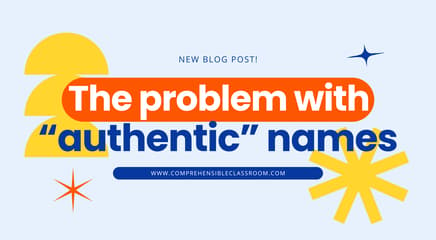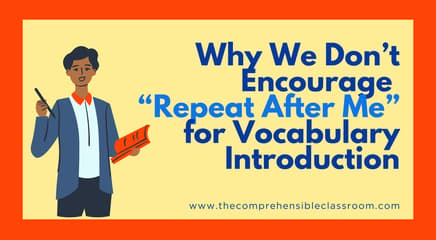Of all the different kinds of things that you do with your students—games, conversation, grammar or vocabulary drills, cultural exploration, etc.—what do you do the MOST?
For me, it’s reading. Nearly everything that we do in class comes back to reading. All of the fun activities and games, the meaningful conversations, the intriguing stories are grounded by this wire that runs through every class: reading.

People acquiring a second language have the best chance of success through reading.
I was recently caught off guard when a teacher asked how she could incorporate reading in her classes. No judgment—I was there once, too. Reading for my students used to consist of attempting to hunt and peck answers to an #authres task on benchmark assessments. Reading in the target language was not part of my own early language learning experience, and the textbook that I used when I started teaching did not provide opportunities for it, either.
But I am not the same teacher that I was back then, and I don’t think the same way that I used to. Now, reading is breathing and comprehensible texts are oxygen.
Reading is breathing
In the same way that respiration is what gives life to our bodies, so does reading (along with listening) give life to the internal, unconscious process of language acquisition that happens in our brains. In the same way that our bodies unconsciously transform into energy the oxygen that we breathe in, so do our brains unconsciously use the language to which we are exposed and understand to build a linguistic system in our heads.

Make reading a part of every class
I first started incorporating more reading with my students because I wanted to read a novel with them. I was transitioning from a class that revolved around cooperative learning activities, vocabulary games, and grammar practice, and I recognized that my students were not equipped with the useful language that they would need in order to understand a novel, nor did they have the stamina to read a text of that length. And so I set about to make reading a part of our daily class life.
So, how do I incorporate reading?
At this point, it's such a part of what I do, that I wonder, ...How can I avoid it?
READ ON THE WAY IN
There are many classroom routines that you can incorporate at the start of class that will assist with management, and reading can be part of them. Here are a few ideas:
IN THE HALL
Using Alina Filipescu’s Passwords? Determined to greet each student with a word of encouragement or a special handshake? Have a perpetual cluster outside your door of students that are not quite ready to pass through the threshold? Get those students reading. Outside your door, post a fact or a puzzle for students to read. Some ideas:
- Bulletin boards related to holidays or special times of the year: for example, many teachers print out our mini-bios during Hispanic Heritage Month or during Women's History month and turn them into a bulletin board for passersby to read.
- Today in History: This idea, which I learned from Justin Slocum Bailey, is a mini-reading activity in which students read four historical events and try to guess which one did NOT happen "today" in history. We have a set for almost every month of the year!
- Fact/Animal/Person/Quote of the day: Find something that would be interesting to your students (the internet is an endless source of content for this!), write it up in the target language, and have your students read it as they wait outside or pass by in the hall.
ENTRY TASK
Jon Cowart partnered with Fluency Matters (now Wayside Publishing) this last week to offer an INCREDIBLE two-part webinar series on classroom management. One of my many takeaways from Jon’s webinar was that there is a reason that bellwork works. When I was teaching at the middle school level, our principal required bellwork. All teachers in the building were required to start class each day by providing a short task for students to complete immediately upon entering the room. If you use The Somos Curriculum (or Nous sommes or Sumus), you see this manifested as the daily Campanada/Clochette.
Note to the reader: Jon continues to offer valuable Classroom Management courses that are designed to support language teachers. Learn more »
Since leaving the classroom, I have learned about primacy/recency, and I had all but decided that whenever I am able to return to the classroom, I would break up with my bell ringer. Jon’s webinar has made me revisit this decision. In his workshop, Jon attests to the value of bell work/entry tasks in setting the tone for the rest of the class: both in terms of compliance and participation. Whether you find yourself in a generally challenging school setting, have a particularly difficult class, or just want to stay ahead of the game with classroom management—establish an entry task routine.
SSR (Sustained Silent Reading)
Several days per week, students can enter the room and choose a text from your class library to read for 5-10 minutes. If you opt for this stepping stone to Free Choice Reading, be certain that your students know how to select texts that are interesting to them and will provide an appropriate challenge.
Read a summary
Project or otherwise give students access to a summary of the previous day’s class. Did you read a chapter of a book? Summarize it! Have a class discussion? Summarize it? Tell a story? Summarize it! Watch a commercial or music video? Summarize it! Learn about a current or historical event? Summarize it! No matter what you did…SUMMARIZE IT (in the target language). You can do this on your own, or you can work with your students to create summaries using an activity like Write and Discuss or Alphaboxes.
As students enter, they should read it and then complete a task.
Some possible tasks are:
- Re-write it from a different perspective (horizontal conjugation)
- Identify an intruding statement (an untruth that you ‘plant’ in the otherwise true story—I learned this from Elizabeth Dentlinger)
- Translate to English
- Summarize the summary (creating a “Shrinking summary”)
- Illustrate it
- Write 1-3 questions about it (matched to QAR types, if you want!)
- Expand it with two words per sentence one new sentence after each existing one
- Copy it down (for use later on)
- React to it (possibly with annotations)
- Identify one personal connection
READ ON THE WAY OUT
An exit ticket can be used in the same ways that you use an entry task. If you have read a text during the class period—or perhaps created a text together—have students complete one of the tasks listed above as an exit ticket, handing you their completed task on a slip of scrap paper on the way out the door. Formative assessment, check!
READ EVERYWHERE IN BETWEEN
No matter what you are doing in class, reading can be part of it:
SONGS
Songs have long been a favorite tool for language teachers because they are engaging to many students. While most song lyrics are not comprehensible in a deep way to Novice and Intermediate language learners, it is easy to create comprehensible texts to accompany them. Here are some ideas:
- Singer biographies, like I include in many of my Canciones contagiosas
- Information about the genre of music, the country of origin, or the inspiration for the song
- Lyrics re-written as narrative (what story is told by the song?), like I do in El chico del apartamento 512
- The story told by the music video, like I did in Espacio sideral
- Teacher-imagined back story or parallel story for the song; like I did for Una canción original
INFORMATIONAL TEXTS
The beautiful thing about teaching with a focus on language acquisition versus a focus on language learning is that your content can be anything! In addition to telling stories to and creating stories with your students, you can study any topic that is of interest to you or your students--and reading can be part of that instruction. Here are just a few ideas:
- Current events, such as the news stories that we publish in El mundo en tus manos. Share news stories from your country, from the target culture, and from other countries with your students!
- Historical events: you don't need a reason to bring the study of any particular historical event into your classes, but often we will explore history as a way to build context or background knowledge for a story or current event in class.
- Cultural insights: Read about the Products, Practices, and Perspectives held by different Peoples that belong to the target culture, or read about Products, Practices, and Perspectives related to your students' cultures. (For ideas of what this might look like, check out our Five ClipChat or our resources for celebrations like Passover.) You can also read about Places, layered in with a whole-group Map Talk or as standalone readings using resources like Lugares inimaginables.
- Biographies, such as the stories we publish in 31 mujeres, 10 artistas, and more.
- Subject area information (science, math, geography, literature…anything that your students are interested in or that connects to what you're studying in class)
- Student interests (sports, the arts, animals, social justice…) - We have tons of resources available for this, including our Criaturas peligrosas series!
- Special person summaries: write biographies of your own students, based on what was shared during Special Person Interviews
- Authentic resources (blog posts, infographics, instructions, etc.) - but take care to make the content comprehensible!

NARRATIVE TEXTS
Reading about real life people, places, and things can be fascinating, but there is nothing quite like a good story. I encourage all teachers to make stories a cornerstone component of their curriculum!
When students read narrative texts, it could happen in one of four ways:
- Students self select texts from the class library to read on their own during sustained silent reading / Free Choice Reading
- We read a story together as a whole class--most often, a short story that I projected on the board; less often, a class novel
- I assign a story for all students to read as part of a lesson, usually a unit from our curriculum.
- I read aloud a story to my students while they listen.

Original stories
- TPRS® stories: Ask a story with your class, then write it up and read it!
- One Word Image stories: create a character with your students, and write up the back story! If you're new to this process, you've got to try our Imagination Labs (available in Spanish and French)
- PQA-spun stories: as you ask your students questions about their lives and interests (maybe using Card Talk), you will often end up with short stories about your students' lives... sometimes real, sometimes with a bit of creative storytelling woven in. Either way, write up the tale and read it!
- Sharing personal experiences from your life or the lives of your students, like Human Tooth Salad!
Existing stories
While my students sometimes read stories on their own, I would usually tell them the story first and then have them read it afterward. Typically when I told my students a story, I would support their comprehension by using student actors to act out the story, illustrating it on the board or overhead or with a felt board, or miming/gesturing it myself. Learn more about strategies for supporting student comprehension here.
The existing stories that I shared with my students mostly fit into one of these six categories:
- Novels written for language learners - there are many excellent options from publishers like Fluency Matters (Wayside Publishing), Command Performance Language Institute, TPRS Books, Mira Canion, and more.
- Legends, like La Llorona, El silbón, El cucuy, and La araña
- Fables, such as Aesop's Fables
- Short stories, such as Continuidad de los parques or the stories available in our Storybuilder PLUS resources!
- Short and feature length films that you have shared using the ClipChat strategy
- Popular fiction
- Familiar children’s stories, like Goldilocks or The Three Little Pigs

Most importantly, read things they understand
As you are filling your students’ linguistic air tanks with fresh texts to breathe (read), make sure that the life-giving oxygen that comes from reading and understanding a text is not too polluted with carbon dioxide: the exhaust of their labored breathing. Oxygen in blood gives life; carbon dioxide in blood kills.
Strive to give your students texts that they can understand well enough to engage in meaningful conversation about them; texts in which they understand not just the main idea, but details as well. Texts that they can understand well enough to make inferences about the content, not just well enough to recall what the text said explicitly (watch this demo to see what I mean!).
As a diver, you depend on the oxygen in your tank to last throughout the dive, but the deeper you go, the faster it’s used up. A text that keeps our students within the depths that they’re comfortable diving will engage and inspire much longer than a text that pushes to their limits.
Know that it is YOUR responsibility to make sure that you present the information or the story of that text to your students in such a way that they understand it. In some of the texts—novels written for language learners or The Somos Curriculum, for example—the work has largely been done for you.
By and large, the work of making the information and the story understandable to your students will fall squarely on your shoulders. “Comprehensifying” is a learned skill that is not easy or simple when you first start to learn it. With time and practice, you will be able to comprehensify texts without skipping a beat.

If simplifying texts is a not yet a skill that you have learned or are interested in doing, try these suggestions to get started:
- Read texts that other teachers have simplified. Pay attention to the words that they use, the way that they structure sentences, and how they simplify ideas.
- Keep a running list of the words that have come up in your class conversations and stories so that you can see at a glance the words that are possibly part of your students’ working vocabulary.
- Get coached by trained CI coaches (if possible) or by more experienced teachers in your area. Trained coaches will be able to help you learn how to know in the moment whether or not your students are understanding you and how to respond when you realize that you are losing them.
- Learn how to equip your students early on with useful language—words and phrasing that they will be able to use to talk about a wide range of things. Considering how your students are exposed to the Super 7 and Sweet 16 is a good starting point, and you will find that with a little practice in comprehensifying the language that you use to communicate with your students, you no longer need to look for strategic opportunities to use these words—they will happen naturally.
Reading is enough
Simply giving your students the opportunity to read texts that they enjoy and can understand is sufficient to access the plentiful benefits to reading for language learners. Do not ever think that you HAVE to assign a task to complete before, during, or after a reading session. If you are, however, looking for activities that students can complete with a text, check out my Reading Activities archive or my Activities Playlist on YouTube for more ideas than you'll ever need:




